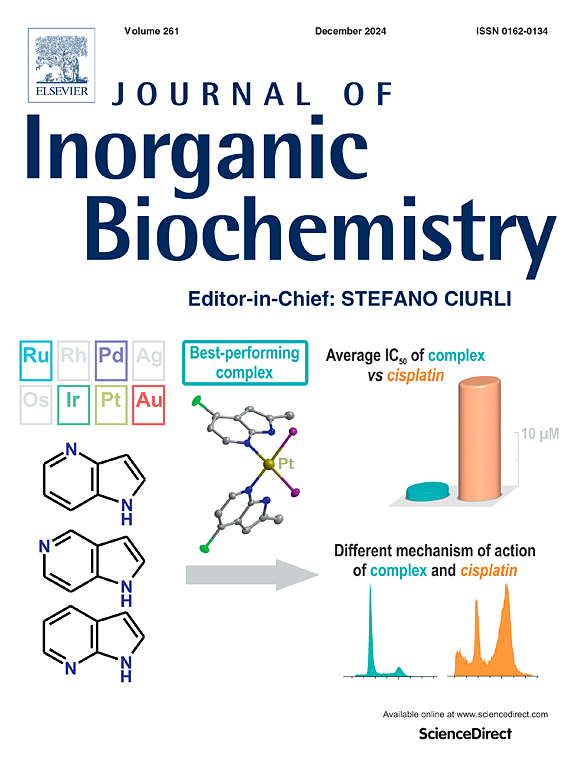锌结合肽作为重组蛋白纯化的潜在标签
IF 3.2
2区 化学
Q2 BIOCHEMISTRY & MOLECULAR BIOLOGY
引用次数: 0
摘要
金属螯合树脂有效结合多肽和蛋白质是现代生化纯化的基石。本研究评估了一个新的七肽序列乙酰-Aa1-Aa2- gly3 - pro4 -Aa5- his6 - cys7,其中Aa1 = His1或Asp1, Aa2 = Cys2或Asp2, Aa5 = Tyr5或Gly5,因为它能够结合锌螯合树脂,该树脂由亚氨基二乙酸螯合二价锌偶联到6%交联琼脂糖珠。采用离子迁移率-质谱分析和紫外吸收分析的内标法与广泛使用的7 × His标签进行了比较,定量了这些肽在pH 8条件下的结合效率和选择性,以及在pH 3.9或过量咪唑下从锌树脂中洗脱。结果表明,七肽乙酰基- his1 - cys2 - gly3 - pro4 - tyr5 - his6 - cys7在固定金属亲和层析和pH值为3.9或过量咪唑的锌树脂中有效洗脱的条件下,与锌螯合树脂具有结合性能,表明该七肽具有替代多组氨酸标签在亲和纯化流程中的潜力。本文章由计算机程序翻译,如有差异,请以英文原文为准。

Alternative zinc binding peptides as potential tags for recombinant protein purification
Efficient binding of peptides and proteins to metal-chelating resins is a cornerstone of modern biochemical purification. This study evaluates a novel heptapeptide sequence, acetyl-Aa1-Aa2-Gly3-Pro4-Aa5-His6-Cys7, where Aa1 = His1 or Asp1, Aa2 = Cys2 or Asp2 and Aa5 = Tyr5 or Gly5 for its capacity to bind zinc-chelating resin consisting of divalent zinc chelated by iminodiacetate coupled to 6 % cross-linked agarose beads. Comparisons were made against the widely utilized 7 × His tag using an internal standard method with ion mobility – mass spectrometry analyses and ultra-violet absorption analyses, which quantified the binding efficiency and selectivity of these peptides under pH 8 conditions and the elution from the zinc resin using pH 3.9 or excess imidazole. Results revealed that the heptapeptides acetyl-His1-Cys2-Gly3-Pro4-Tyr5-His6-Cys7, exhibited binding performance to the zinc chelating resin with conditions commonly used with immobilized metal affinity chromatography and efficient elution from the zinc resin at pH 3.9 or with excess imidazole, suggesting that this heptapeptide has potential as an alternative to polyhistidine tags in affinity-based purification workflows.
求助全文
通过发布文献求助,成功后即可免费获取论文全文。
去求助
来源期刊

Journal of Inorganic Biochemistry
生物-生化与分子生物学
CiteScore
7.00
自引率
10.30%
发文量
336
审稿时长
41 days
期刊介绍:
The Journal of Inorganic Biochemistry is an established international forum for research in all aspects of Biological Inorganic Chemistry. Original papers of a high scientific level are published in the form of Articles (full length papers), Short Communications, Focused Reviews and Bioinorganic Methods. Topics include: the chemistry, structure and function of metalloenzymes; the interaction of inorganic ions and molecules with proteins and nucleic acids; the synthesis and properties of coordination complexes of biological interest including both structural and functional model systems; the function of metal- containing systems in the regulation of gene expression; the role of metals in medicine; the application of spectroscopic methods to determine the structure of metallobiomolecules; the preparation and characterization of metal-based biomaterials; and related systems. The emphasis of the Journal is on the structure and mechanism of action of metallobiomolecules.
 求助内容:
求助内容: 应助结果提醒方式:
应助结果提醒方式:


